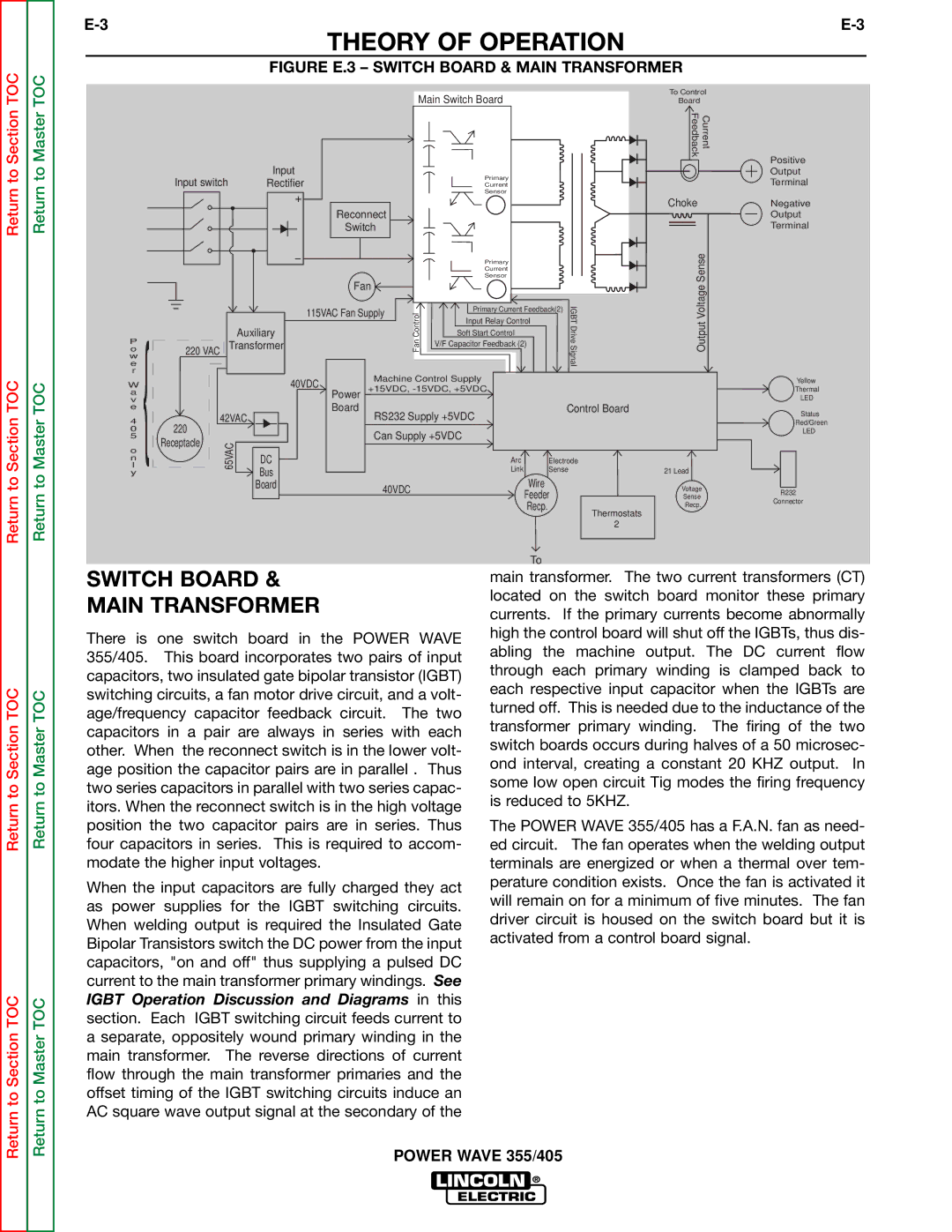
THEORY OF OPERATION
FIGURE E.3 – SWITCH BOARD & MAIN TRANSFORMER
Return to Master TOC
Return to Master TOC
P
o { w
e
r
W
a v e
4
0
5
o n l y
Main Switch Board
Input
Input switch |
| Rectifier |
|
| Primary |
|
|
| |
|
|
| Current |
|
|
| |||
|
|
|
|
|
| Sensor |
|
|
|
|
|
| Reconnect |
|
|
|
|
| |
|
|
| Switch |
|
|
|
|
| |
|
|
|
|
|
| Primary |
|
|
|
|
|
|
|
|
| Current |
|
|
|
|
|
|
|
|
| Sensor |
|
|
|
|
|
| Fan |
|
|
|
| TD | |
|
|
|
|
|
| Primary Current Feedback(2) | |||
|
|
| 115VAC Fan Supply | ControlFan | IGBriveSignal | ||||
|
|
| Input Relay Control |
| |||||
|
|
|
|
|
| ||||
|
|
|
|
|
|
|
| ||
|
|
| Auxiliary |
|
| Soft Start Control |
|
|
|
220 VAC |
| Transformer |
|
| V/F Capacitor Feedback (2) |
|
| ||
|
|
|
|
|
|
| |||
|
|
| 40VDC | Machine Control Supply |
|
|
| ||
|
|
| +15VDC, |
|
|
| |||
|
|
| Power |
|
|
| |||
|
|
| Board | RS232 Supply +5VDC |
|
| Control Board | ||
220 | 42VAC |
|
|
| |||||
|
|
| Can Supply +5VDC |
|
|
| |||
Receptacle | 65VAC |
|
|
|
| ||||
|
|
|
|
|
|
| |||
| DC |
|
| Arc |
| Electrode | |||
|
|
| Bus |
|
| Link | Wire | Sense | |
|
|
| Board | 40VDC |
|
|
|
| |
|
|
|
|
|
| Feeder |
| ||
|
|
|
|
|
|
|
| ||
|
|
|
|
|
|
| Recp. |
| Thermostats |
|
|
|
|
|
|
|
|
| |
|
|
|
|
|
|
|
|
| 2 |
To
To Control
Board
Feedback | Current |
Choke
SenseVoltage
Output
21 Lead
Voltage
Sense
Recp.
Positive
Output
Terminal
Negative
Output
Terminal
Yellow
Thermal
LED
Status
Red/Green
LED
R232
Connector
Return to Section TOC
Return to Section TOC
Return to Section TOC
Return to Section TOC
Return to Master TOC
Return to Master TOC
SWITCH BOARD &
MAIN TRANSFORMER
There is one switch board in the POWER WAVE 355/405. This board incorporates two pairs of input capacitors, two insulated gate bipolar transistor (IGBT) switching circuits, a fan motor drive circuit, and a volt- age/frequency capacitor feedback circuit. The two capacitors in a pair are always in series with each other. When the reconnect switch is in the lower volt- age position the capacitor pairs are in parallel . Thus two series capacitors in parallel with two series capac- itors. When the reconnect switch is in the high voltage position the two capacitor pairs are in series. Thus four capacitors in series. This is required to accom- modate the higher input voltages.
When the input capacitors are fully charged they act as power supplies for the IGBT switching circuits. When welding output is required the Insulated Gate Bipolar Transistors switch the DC power from the input capacitors, "on and off" thus supplying a pulsed DC current to the main transformer primary windings. See IGBT Operation Discussion and Diagrams in this section. Each IGBT switching circuit feeds current to a separate, oppositely wound primary winding in the main transformer. The reverse directions of current flow through the main transformer primaries and the offset timing of the IGBT switching circuits induce an AC square wave output signal at the secondary of the
main transformer. The two current transformers (CT) located on the switch board monitor these primary currents. If the primary currents become abnormally high the control board will shut off the IGBTs, thus dis- abling the machine output. The DC current flow through each primary winding is clamped back to each respective input capacitor when the IGBTs are turned off. This is needed due to the inductance of the transformer primary winding. The firing of the two switch boards occurs during halves of a 50 microsec- ond interval, creating a constant 20 KHZ output. In some low open circuit Tig modes the firing frequency is reduced to 5KHZ.
The POWER WAVE 355/405 has a F.A.N. fan as need- ed circuit. The fan operates when the welding output terminals are energized or when a thermal over tem- perature condition exists. Once the fan is activated it will remain on for a minimum of five minutes. The fan driver circuit is housed on the switch board but it is activated from a control board signal.
